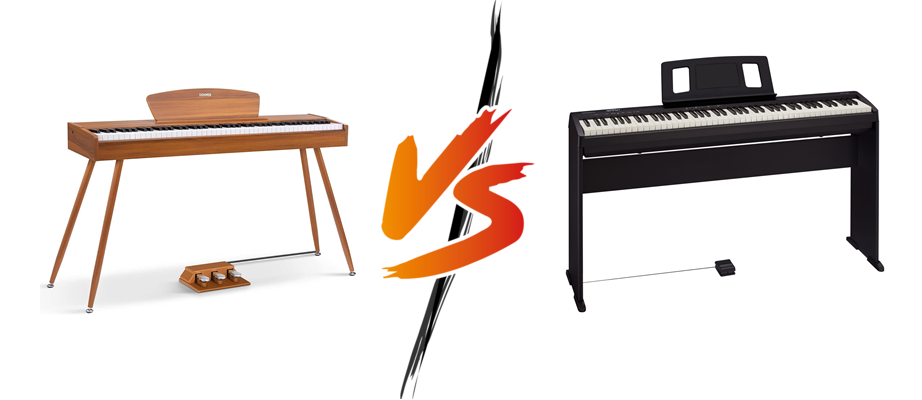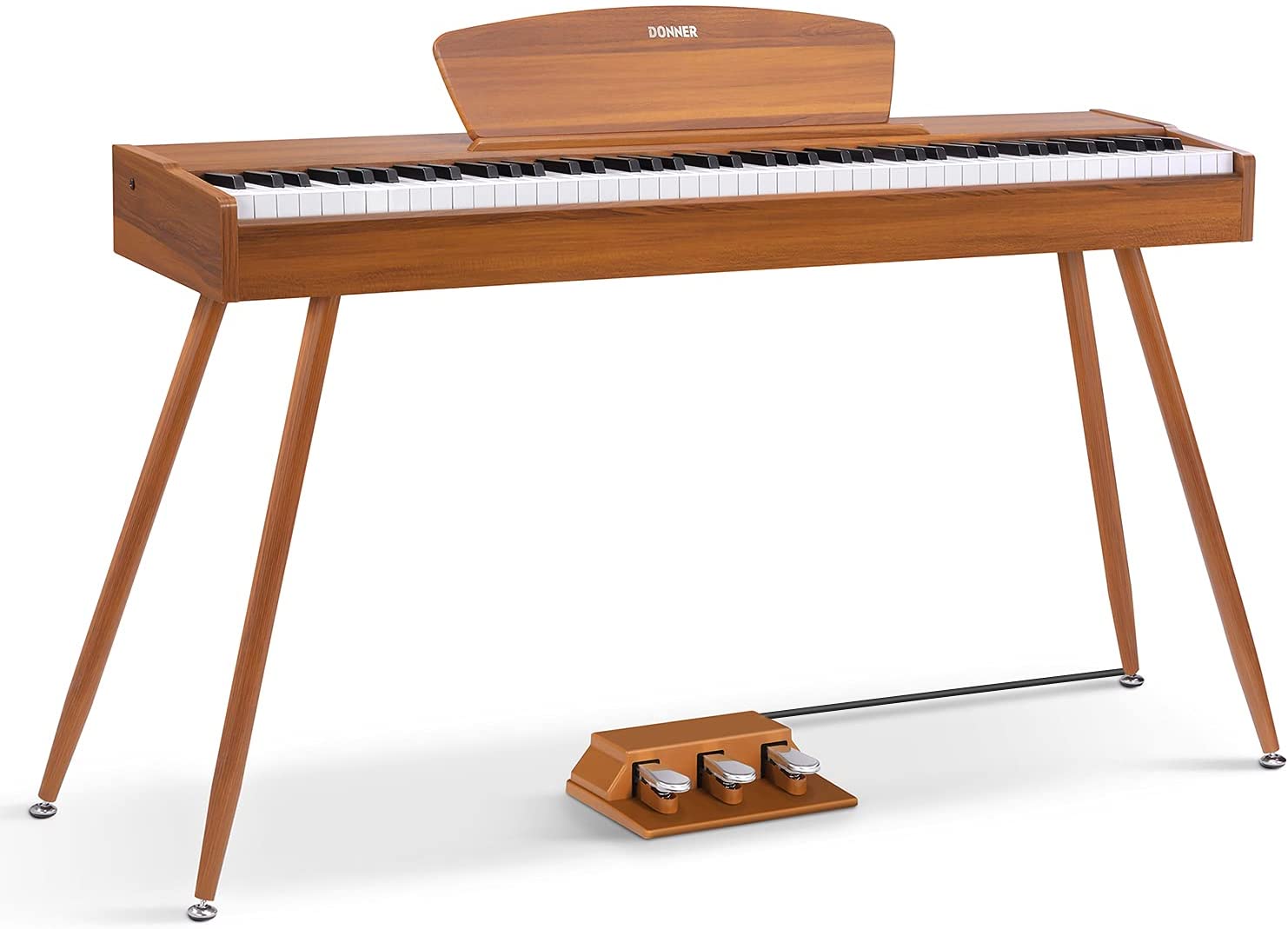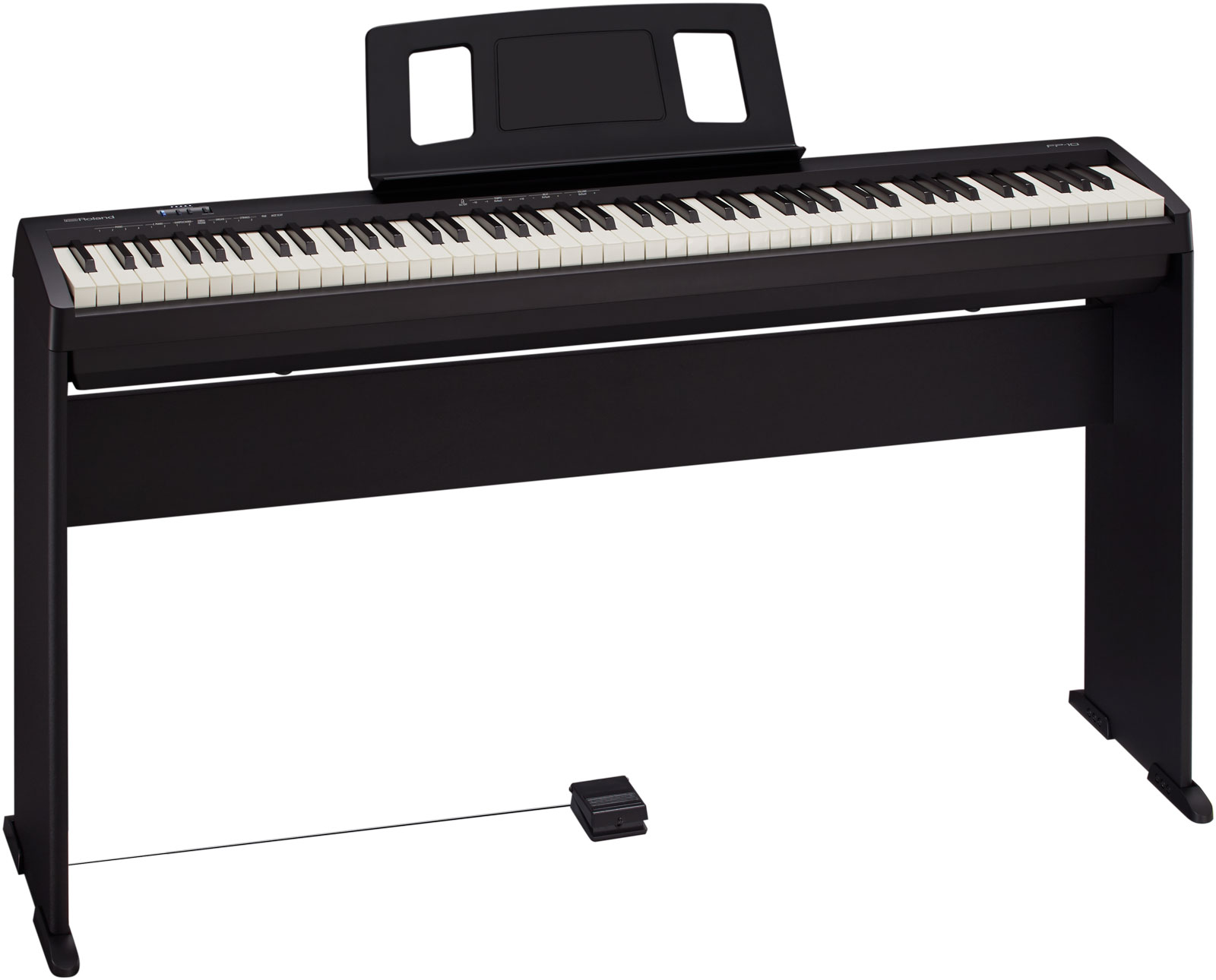
When it comes to buying a digital piano, especially for beginners or intermediate players, two models that frequently come up in conversation are the Donner DDP-80 and the Roland FP-10. Both of these instruments are designed to offer realistic piano experiences at accessible price points, but they differ in several key areas. In this review, we’ll dive into the intricacies of both the Donner DDP-80 and Roland FP-10, analyzing their design, keyboard feel, sound quality, speakers, functionality, connectivity, and value for money.
Donner DDP-80 vs Roland FP-10 Comparison Chart
Here’s a detailed comparison table outlining the key specifications of the Donner DDP-80 and the Roland FP-10:
If you click the links below, under the product images you will be redirected to Amazon.com. In case you then decide to buy anything, Amazon.com will pay me a commission. This doesn’t affect the honesty of this review in any way though.
| Feature | Donner DDP-80 | Roland FP-10 |
|---|---|---|
 |  | |
| Check best price on Amazon | Check best price on Amazon | |
| Price | Lower, budget-friendly | Slightly higher, but offers more features |
| Design | Wooden cabinet, upright style | Compact, modern plastic chassis |
| Weight | Approx. 78 lbs (35.4 kg) | Approx. 27 lbs (12.3 kg) |
| Portability | Low (designed for stationary use) | High (lightweight and portable) |
| Keyboard Action | Fully Weighted, Hammer-Action | PHA-4 Standard with Escapement and Ivory Feel |
| Number of Keys | 88 | 88 |
| Key Finish | Matte | Ivory-feel surface |
| Touch Sensitivity | Adjustable | Adjustable (5 levels) |
| Sound Engine | Custom sound engine | Roland SuperNATURAL Sound Engine |
| Polyphony | 128 notes | 96 notes |
| Instrument Voices | 1 (Grand Piano) | 15 (including Grand Piano, Electric Piano, etc.) |
| Built-in Speakers | 2 x 20W speakers | 2 x 6W speakers |
| Headphone Jacks | 1/4″ jack | 1/8” stereo mini and 1/4” stereo headphone jacks |
| Pedals | 3 pedals (soft, sostenuto, sustain) | Sustain pedal included (can add a pedal unit) |
| Bluetooth MIDI | No | Yes |
| USB MIDI | Yes | Yes |
| Other Connectivity | None | Bluetooth audio, USB port |
| Recording Function | No | Yes (through compatible apps via Bluetooth) |
| Metronome | No | Yes |
| Split/Dual Mode | No | Yes (dual and split modes available) |
| Dimensions | 134.5 x 29.9 x 79.7 cm | 128.4 x 25.8 x 15.0 cm |
| Included Accessories | Wooden stand, built-in pedals | Sustain pedal, music rest |
| Target Audience | Beginners and home users | Beginners to intermediate players |
| Donner DDP-80 review | Roland FP-10 review |
Key Takeaways:
- Donner DDP-80 focuses on aesthetics and simplicity, providing an attractive, furniture-style piano at an affordable price but with limited features.
- Roland FP-10 offers a more versatile and portable option with better key action, superior sound quality, and advanced features like Bluetooth MIDI, making it a great choice for players looking for more functionality and growth potential.
Overview
Before we delve into specific aspects, let’s briefly summarize what each piano offers:
- Donner DDP-80 is a digital piano primarily aimed at beginner to intermediate players who are looking for an aesthetically pleasing, home-focused instrument. It has a minimalist wooden design, 88 fully weighted keys, and a focus on delivering a simple but solid piano experience.
- Roland FP-10 is Roland’s entry-level digital piano, offering their respected piano technology at an affordable price point. It’s designed with versatility in mind, suitable for both home and gigging musicians, thanks to its compact and portable form.
Both pianos aim to provide realistic piano sounds and playability, but their designs, features, and target audiences have some notable differences.
Design and Build Quality
The first thing you’ll notice about any piano is how it looks and feels, and the Donner DDP-80 and Roland FP-10 present very different aesthetics and build philosophies.
Donner DDP-80: Aesthetics and Classic Design
The Donner DDP-80 stands out immediately due to its elegant, vintage-inspired design. It features a full wooden cabinet, which is unusual at this price point, making it an attractive addition to any living space. The piano looks like an acoustic upright, with a mid-century modern vibe. It’s available in a wood-grain finish that adds a premium touch.
While this design is visually appealing, it also means the DDP-80 is less portable than some other digital pianos in its class, including the Roland FP-10. The Donner is better suited for players who plan to keep it in one place, like a home studio or living room. The overall build quality feels solid, though it doesn’t quite reach the high-end durability of more expensive models.
Roland FP-10: Portable and Functional
In contrast, the Roland FP-10 has a modern, minimalist design that prioritizes portability. It’s a sleek, compact digital piano with a lightweight plastic chassis. While it doesn’t look as premium or home-friendly as the Donner DDP-80, the FP-10’s design focuses on functionality and ease of transport.
The Roland FP-10 weighs about 27 lbs (12.3 kg), significantly lighter than the Donner. Its compact size means it can easily be moved, making it a great choice for gigging musicians, students, or those with limited space. However, some may find the Roland FP-10’s utilitarian design to be less inspiring aesthetically, particularly if the piano will serve as a permanent fixture in a home environment.
Keyboard Action and Feel
For any pianist, the feel of the keyboard is critical, and both of these digital pianos aim to replicate the touch of an acoustic piano.
Donner DDP-80: Fully Weighted Keys
The Donner DDP-80 features 88 fully weighted keys with hammer-action simulation. The weighting gives a reasonably realistic touch for its price range, providing the resistance you’d expect from an acoustic piano. While it’s not on par with high-end digital pianos, for beginners or casual players, it offers a solid playing experience.
One of the standout aspects of the DDP-80 is its key finish. The keys have a matte coating that prevents slipping, especially useful during extended practice sessions. However, some users have noted that the responsiveness can feel slightly sluggish compared to more premium instruments, particularly for advanced pianists who require high sensitivity for fast, intricate passages.
Roland FP-10: PHA-4 Standard Action
The Roland FP-10, on the other hand, comes equipped with Roland’s PHA-4 Standard action, which is one of the most highly regarded key actions in this price range. The PHA-4 action features escapement and ivory-feel keys, offering a highly authentic playing experience. Escapement is a subtle “notch” feeling you get when pressing keys slowly, mimicking the mechanism of a grand piano.
The keys on the FP-10 respond excellently to dynamics, making it easy to express a range of volumes and tones. The ivory texture on the keys is a nice touch, providing a comfortable feel that improves grip. Compared to the DDP-80, the Roland FP-10 offers a superior key action that feels closer to a real acoustic piano, making it a better choice for more serious pianists who are sensitive to touch and response.
Sound Quality
Sound quality is one of the most important considerations when choosing a digital piano, and both models approach this with different technology.
Donner DDP-80: Basic But Satisfying
The Donner DDP-80 uses a custom sound engine designed to deliver a realistic piano sound. It’s important to note that the DDP-80 primarily focuses on its grand piano sound rather than offering a wide variety of instrument voices. This makes it a good choice for players who want a simple, focused experience without extra bells and whistles.
The piano tone is decent for the price point, with enough richness and depth to satisfy beginners. However, the sample quality and dynamic range don’t quite match up to the Roland FP-10. Advanced players may find the sound to lack nuance, particularly in terms of responsiveness to dynamic changes like softer playing or aggressive fortissimos.
Roland FP-10: SuperNATURAL Sound Engine
The Roland FP-10 uses Roland’s well-regarded SuperNATURAL sound engine, which provides an incredibly realistic and dynamic piano sound. The SuperNATURAL engine uses detailed modeling rather than simple sampling, resulting in a sound that closely mimics the complex tonal variations of an acoustic piano.
The FP-10’s piano sound has more depth and expressiveness than the Donner DDP-80. It responds well to changes in dynamics and articulation, making it a great instrument for both beginners and intermediate players who want to develop their touch and control. Additionally, the FP-10 offers a variety of different instrument sounds, including electric pianos, strings, and organs, giving users more versatility.
Overall, in terms of sound quality, the Roland FP-10 is the clear winner. Its tone is richer, more expressive, and offers more depth than the Donner DDP-80, which, while good for its price, doesn’t match Roland’s advanced sound modeling.
Speakers
A digital piano’s built-in speakers can significantly impact the overall playing experience, particularly if you’re not using external amplification.
Donner DDP-80: Decent Home Use Speakers
The Donner DDP-80 is equipped with a pair of 20-watt speakers, which are sufficient for home practice or playing in a small room. The sound output is relatively clean, but the lower wattage means it may lack the power needed to fill larger spaces. The speakers project sound decently, but the overall volume is limited, and the bass response can be a bit weak compared to higher-end models.
Roland FP-10: Impressive for Its Size
Despite its compact form, the Roland FP-10 delivers surprisingly powerful sound through its 6-watt speakers. While the wattage may seem low on paper, Roland has optimized the speaker placement and acoustic design to project sound with more clarity and punch than you’d expect. It can easily fill a medium-sized room, and the sound remains crisp even at higher volumes.
While the FP-10’s speakers are excellent for its size, some players may still prefer to use headphones or external speakers for more powerful sound or better bass response. Still, considering the portability of the FP-10, its speaker performance is impressive.
In terms of pure speaker power, the Donner DDP-80’s 20-watt output is higher, but the Roland FP-10’s superior sound projection and clarity make it more competitive than the numbers suggest.
Features and Functions
Digital pianos often come with a variety of features designed to enhance the playing experience. Let’s see how the DDP-80 and FP-10 stack up.
Donner DDP-80: Simple and Focused
The Donner DDP-80 takes a no-frills approach to digital piano functionality. It focuses heavily on being a digital piano that replicates an acoustic piano experience, so you won’t find many extra features like those in more advanced models. It comes with three built-in pedal functions (soft, sostenuto, and sustain), which are integrated into its cabinet.
This minimalistic approach is both a strength and a weakness. For beginners who don’t want to deal with complex menus or functions, the DDP-80’s simplicity is a benefit. However, more advanced players may find its lack of features limiting. There are no built-in rhythms, very few voices, and no recording function.
Roland FP-10: Versatile and Feature-Rich
The Roland FP-10 offers a wide range of features, making it a far more versatile instrument. It comes with 15 preset instrument sounds, allowing players to switch between grand pianos, electric pianos, strings, organs, and more. Additionally, the FP-10 includes functions like metronome, recording, dual/split modes (allowing two instrument sounds to be layered or split across the keyboard), and transposition.
One standout feature of the Roland FP-10 is Bluetooth MIDI connectivity, which opens up a wealth of possibilities. You can connect the piano to your tablet or computer and use apps like Roland’s Piano Partner 2 or DAWs (Digital Audio Workstations) for recording and composition.
In terms of features, the Roland FP-10 far outshines the Donner DDP-80. It offers more flexibility and advanced functionality that can cater to both beginners and intermediate players looking to explore beyond basic piano practice.
Connectivity
Connectivity is an increasingly important aspect of digital pianos, especially for musicians who want to integrate their instruments with digital devices or sound systems.
Donner DDP-80: Limited Connectivity
The Donner DDP-80 offers basic connectivity options, including:
- A 1/4” headphone jack
- A USB-MIDI output, allowing you to connect the piano to a computer or tablet for MIDI control
However, it lacks more advanced connectivity options like Bluetooth, which could make it less appealing to players who want to use apps or record music wirelessly.
Roland FP-10: Bluetooth and USB
The Roland FP-10 excels in connectivity options. It includes:
- Bluetooth MIDI, allowing you to wirelessly connect to devices for use with apps, DAWs, or even online piano lessons
- USB-MIDI, offering traditional wired connectivity for those who prefer a more stable connection
- 1/8” and 1/4” headphone jacks, giving flexibility in terms of audio output
The inclusion of Bluetooth MIDI on the FP-10 gives it a significant edge over the Donner DDP-80, particularly for musicians who want to integrate technology into their practice or performance setup.
Portability and Space Considerations
Donner DDP-80: Larger and Heavier
The Donner DDP-80, with its wooden stand and cabinet design, is significantly bulkier and heavier than the Roland FP-10. This piano is meant to be a more permanent fixture in a home environment, and moving it around frequently isn’t practical. If you have ample space and prefer the aesthetic of an upright piano, this could be a good option, but it’s not ideal for those who need to move their instrument regularly.
Roland FP-10: Compact and Lightweight
The Roland FP-10, by contrast, is one of the most portable digital pianos in its class. Its lightweight, compact design makes it easy to move from room to room or take to gigs. It’s a great option for musicians who need portability without sacrificing too much in terms of sound and playability. Additionally, because it’s so compact, the FP-10 is ideal for smaller living spaces or apartments.
Value for Money
Donner DDP-80: A Budget-Friendly Option
The Donner DDP-80 is priced competitively, making it an excellent value for beginners or those on a budget who want a digital piano with a weighted keybed and a stylish, home-friendly design. However, the limited features and average sound quality mean that more serious players may outgrow it relatively quickly.
Roland FP-10: Packed with Value
The Roland FP-10, while slightly more expensive, offers significantly more value for the price. With superior key action, sound quality, and a host of additional features (like Bluetooth and various instrument sounds), the FP-10 is a more future-proof investment. Even intermediate players will find a lot to love here, making it one of the best options in the entry-level digital piano market.
Conclusion: Which One is Best for You?
Both the Donner DDP-80 and Roland FP-10 have their strengths and cater to different types of players.
- Choose the Donner DDP-80 if you’re a beginner looking for an affordable, stylish digital piano that will stay in one place. Its attractive design and simple functionality make it a solid choice for casual players or those who are just starting their piano journey.
- Choose the Roland FP-10 if you’re looking for an instrument with more advanced features, better key action, and superior sound quality. The FP-10 is ideal for players who want a piano that they can grow with, thanks to its versatile functions, connectivity options, and portability.
In the end, the Roland FP-10 edges out the Donner DDP-80 as the better overall instrument, particularly for those who value a more authentic piano experience, but the Donner DDP-80 offers excellent value for those prioritizing budget and aesthetics.
